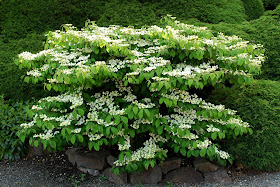Doublefile viburnum, Viburnum plicatum var. tomentosum 'Snowflake', a sculptural, layered shrub with creamy-white lacecap flowers.
Have you ever heard anybody to say that they just love Viburnums? Not often, I assume, even if they are such deserving plants. And maybe that's just the problem; they are far too accommodating to really be the stars of a garden. Still, there are such a variety of great species and cultivars to be grown; some of them evergreen, some highly fragrant, some with beautiful form and/or flowers,some with great fruit and some with vibrant autumn color. No single Viburnum really combines all of these features, but then, that kind of a sensory overload might be hard to handle...

Viburnum opulus 'Roseum' and the wild species, V. opulus; both are great, large shrubs for the wilder parts of the garden.
With its mild climate, the Pacific Northwest is a heaven for growing almost any of the around 180 species of Viburnums. One of the oldest garden varieties is the snowball tree, or V. opulus 'Roseum'; it has been deservedly popular in European gardens since the 17th century. I've always loved the creamy lime-color of the unfurling globes of flowers. This and the wild species called European cranberry bush, V. opulus, are both great transition plants between the more formal and informal parts of the garden, or as in my garden in Sweden, where the forest takes over. The birds love the opulus-berries which is a bonus.
The highly fragrant flowers of Viburnum x Burkwoodii. It is semi-evergreen in cold climates.
Of the sweetly fragrant ones, V. x bodnantense 'Dawn" is one of the earliest to flower, starting in November or December and continuing until late February in these mild climates. Later in March or April, V. x Burkwoodii has a similar scent, reminding of both lilacs and lily-of-the-valleys at the same time. I had a large, old specimen in my garden in Melbourne and I loved coming home through the garden gate as my Burkwoodii gave me a scented welcome in early spring.
V. rhytidophyllum, an evergreen viburnum for milder climates. A bit coarse-looking, but a great background for other plants.
Most of the evergreen ones are too fragile for Scandinavia, where only the toughest like V. 'Eskimo' are semi-evergreen at their best, just like the scented V. x Burkwoodii above. In my present garden, I grow several other tough viburnum species, like the leatherleaf viburnums V. davidii and V. rhytidophyllum. None of them are really exciting, but they offer a great year around structure and background in the garden.
Viburnum plicatum tomentosum 'Mariesii', here in my neighbor's garden in Seattle.
If I should name my favorite Viburnum (besides the old-fashioned snowball tree that I have loved since I was tiny), it probably would be the doublefile viburnum, V. plicatum tomentosum. It has a great sculptural, layered form and clean, white flowers that hover elegantly above the sligthly veined leaves. 'Mariesii' is one of the best cultivars, with slender, arching stems; it needs space around it and preferably a darker green background to be appreciated properly. But I'd rather not to be restricted to only one cultivar, as there are such a variety of great plants to choose from.
A Chinese evergreen viburnum that I don't know the exact name for - a new find that I'm fond of, I like its slender, evergreen leaves and fragrant, delicate flowers. A must have, here we go again...







You're far more knowledgeable than I am Liisa...reminding me of the scent of Viburnum as you have, I am transported...
ReplyDeleteI was just thinking about the large snowball bush in my previous yard and missing it. This time of year, it was always glorious. Our new yard is probably too small for such a plant, but thanks for the reminder that there are lots of other viburnums that could work well here.
ReplyDeleteWonderful post Liisa! These are some of my favorite shrubs. Kram/Carol
ReplyDelete